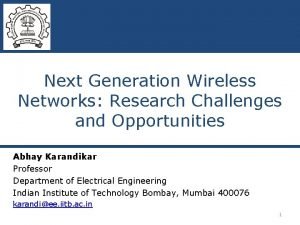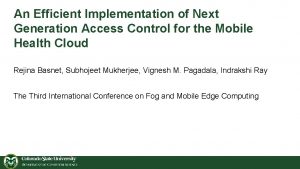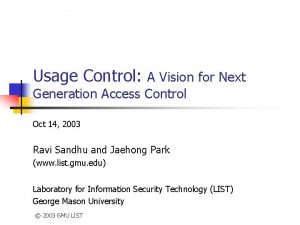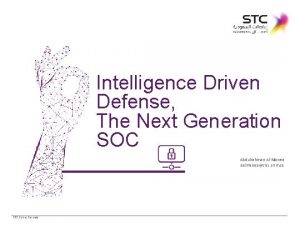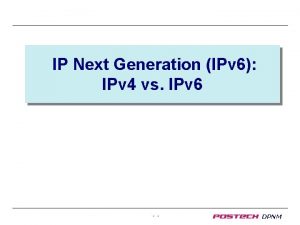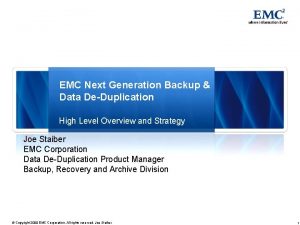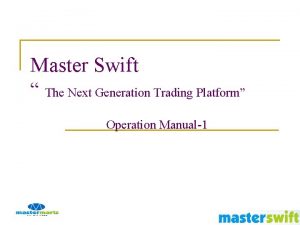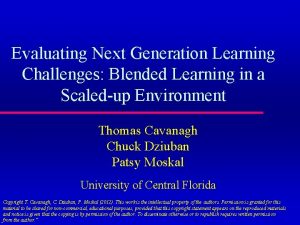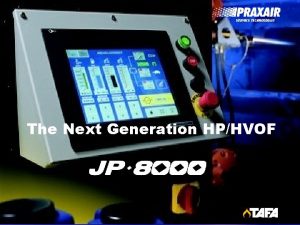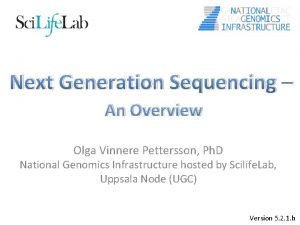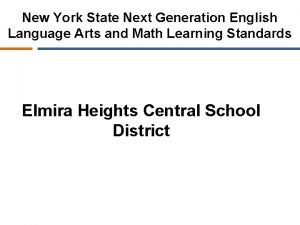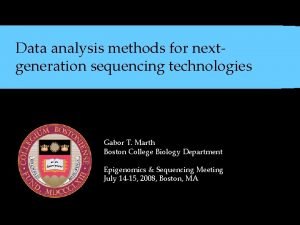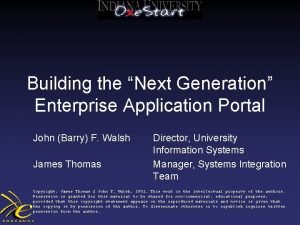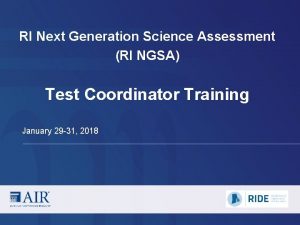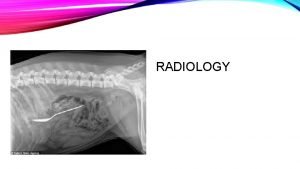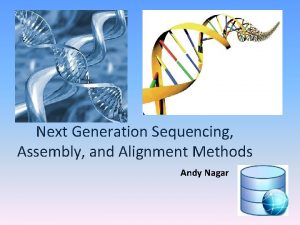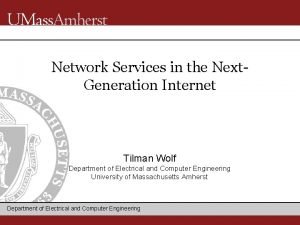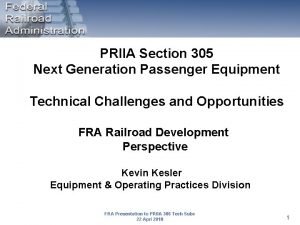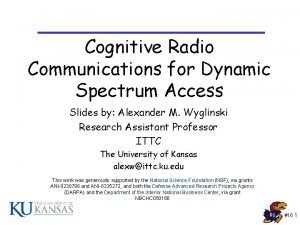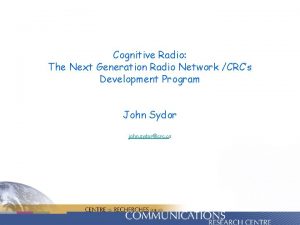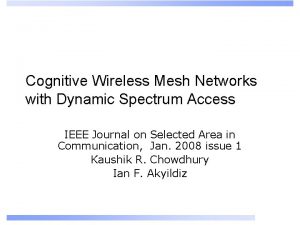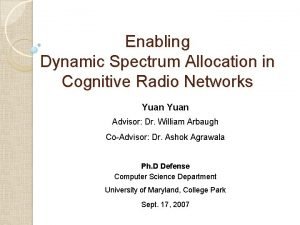Next Generation Dynamic Spectrum Access Cognitive Radio Wireless





















































- Slides: 53

Next Generation Dynamic Spectrum Access Cognitive Radio Wireless Networks 2021/3/10 1

Current State g Wireless networks regulated by a fixed spectrum assignment policy i. FCC i. Assigned to license holder or services on a long term basis for large geographical regions i. Large portion of the assigned spectrum used sporadically i. Spectrum usage concentrated on certain portion of the spectrum i. A significant amount of spectrum unutilized Temporal and geographical utilization variation 15%-85% i. There has been dramatic increase in the access to the limited spectrum for mobile services i. Spectrum scarcity problem • 2021/3/10 2

Spectrum Utilization 2021/3/10 3

Dynamic Spectrum Access g g A new communication paradigm to exploit existing wireless spectrum opportunistically Opportunistic access to licensed bands without interfering with the existing users Solve the spectrum scarcity problem Key enabling technology of DSA networks is the cognitive radio i. Provide capability to use or share spectrum in an opportunistic manner 2021/3/10 4

Main Functions of Cognitive Radio g Spectrum sensing i. Detect unused spectrum i. Share the spectrum without harmful interference with other users g Spectrum management i. Capture the best available spectrum to meet user communication requirements g Spectrum mobility i. Maintain seamless communication requirements during the transition to better spectrum g Spectrum sharing i. Provide the fair spectrum scheduling method among coexisting users 2021/3/10 5

DSA Network Communication Functionalities 2021/3/10 6

Cognitive Radio g g A radio that can change its transmitter parameters based on interaction with the environment in which it operates Two main characteristics i. Cognitive capability • Capture and sense information from its radio environment • Capture temporal and spatial variations and avoid interference to other users • Id portions of spectrum that are unused at a specific time or location • Select best spectrum and appropriate operating parameters 2021/3/10 7

i. Re-configurability • Enable the radio to be dynamically programmed according to the radio environment • Radio programmed to transmit and receive on a variety • • 2021/3/10 of frequencies and to use different transmission access technologies supported by its hardware design Use temporally unused spectrum – spectrum hole Move to another spectrum hole or Stays in the same band, altering its transmission power level or Modulation scheme to avoid interference 8

Spectrum Holes or White Space g Temporally unused spectrum 2021/3/10 9

Physical Architecture of Cognitive Radio g Accurate detection of weak signals of licensed users over a wide spectrum range 2021/3/10 10

Physical Architecture of Cognitive Radio g A wideband signal received through RF front-end i. Receive signals from various transmitters operating at different power levels, bandwidths, and locations i. Capability to detect weak signal in a large dynamic range g Sampled by high speed A/D converter g Measurements are performed for the detection of licensed user signal i. Require a multi-GHz speed A/D with high resolution i. Filter strong signals before A/D i. Use multiple antennas, spatial signal filtering i. Multiple antennas – beamforming techniques 2021/3/10 11

Cognitive Capability – Cognitive Cycle g Spectrum sensing i. Monitor the available spectrum bands, captures their information, and detect the spectrum holes g Spectrum analysis g Spectrum decision i. Estimate the characteristics of spectrum holes detected i. Determine data rate, transmission mode, and bandwidth i. Choose appropriate spectrum band according to the spectrum characteristics and user requirements 2021/3/10 12

Cognitive Cycle 2021/3/10 13

Reconfigurability g g Adjust operating parameters for the transmission on the fly without any modification on the hardware components – software programmable Reconfigurable parameters i. Operating frequency i. Modulation: adaptive to user requirements and channel conditions, e. g. , delay (high bandwidth), loss (low error rate) i. Transmission power i. Communication technology: provide interoperability among different communication systems 2021/3/10 14

DSA Network Architecture 2021/3/10 15

Components of DSA Network Architecture g Primary network g x. G network i. Primary user i. Primary base-station ix. G user ix. G base-station i. Spectrum broker • Network entity that plays a role in sharing the spectrum resources among different x. G networks • Can be connected to each network and serve as a spectrum information manager to enable coexistence of multiple x. G networks 2021/3/10 16

Access Types in x. G Networks g x. G network access ix. G users access their own x. G base-station both on licensed and unlicensed spectrum bands g x. G ad hoc access ix. G users communicate with other x. G users via ad hoc connection on both licensed and unlicensed spectrum bands g Primary network access ix. G users access the primary base-station via licensed band 2021/3/10 17

x. G Networks on Licensed Band 2021/3/10 18

x. G Networks on Licensed Band g g g Temporally unused spectrum holes in licensed band Exploit spectrum holes Challenges i. Detection of the presence of primary users i. Interference avoidance with primary users i. Spectrum handoff • x. G users vacate the current spectrum band move to new available spectrum 2021/3/10 19

x. G Networks on Unlicensed Band 2021/3/10 20

x. G Networks on Unlicensed Band g g g No license holder, equal right to use for all Open spectrum policy in ISM band – industrial scientific and medical Spectrum efficiency of ISM band decreases due to increased interference Capacity of open spectrum access and Qo. S depend on efficient spectrum allocation and intelligent spectrum sharing No spectrum handoff Sophisticated fair spectrum sharing among networks needed 2021/3/10 21

x. G Network Applications g Leased network i. Primary network provides a leased network by allowing opportunistic access to its licensed spectrum without sacrificing the Qo. S of the primary user g Cognitive mesh network i. A meshed wireless backbone network of infrastructure links established based on cognitive access points and fixed cognitive relay nodes i. Mesh network deployed in dense urban areas to provide temporary or permanent spectrum to the infrastructure links used for relaying in case of high traffic load g g Public safety and emergency network Military network i. Enable military radios to choose arbitrary, intermediate frequency bandwidth, modulation schemes, and coding schemes, adapting to the variable radio environment of battlefield i. Handoff to find secure spectrum – protection and security in hostile 2021/3/10 environment 22

Existing Architecture – one example g g IEEE 802. 22 in the process of standardization First worldwide standard based on cognitive radio technology Standard for wireless regional area networks (WRAN) Fixed point-to-multipoint WRAN i. Utilize UHF/VHF TV bands 54 – 862 MHz i. Base-station coverage up to 100 km i. Base-station manages a unique feature of distributed sensing i. Ensure proper incumbent protection g First draft ready around mid 2006 2021/3/10 23

Spectrum Sensing g g Difficult for a cognitive radio to have a direct measurement of a channel between a primary receiver and a transmitter Feasible approach i. Primary transmitter detection based on local observation of x. G users 2021/3/10 24

Spectrum Sensing 2021/3/10 25

Transmitter Detection g Based on the detection of the weak signal from a primary transmitter via the local observations of x. G users Matched filter detection g Energy detection g i. Information of the primary user signal is known to x. G user i. If the receiver cannot gather sufficient info about the primary user signal, optimal detector – an energy detector i. Cannot differentiate signal types, only presence g Cyclostationary feature detection i. Analyze a spectral correlation function i. Computationally complex and require significantly long observation time i. Classify signals into different modulation types 2021/3/10 26

Cooperative Detection g Spectrum sensing methods where information from multiple x. G users are incorporated for primary user detection Centralized g Distributed g Advantages g Disadvantages g ix. G base-station gather all sensing info from x. G users and i. Detect spectrum holes i. Exchange observations among x. G users i. More accurate – minimize uncertainty in a single user’s detection i. Reduce multi-path fading and shadowing effect i. Data transmission and spectrum sensing function co-located i. Suboptimal spectrum decision due to possible conflicts between data transmission and spectrum sensing 2021/3/10 27

Interference Temperature Model 2021/3/10 28

Interference-based Detection g g g Interference takes place at the receivers The interference temperature model manages interference at the receiver through the interference temperature limit – the amount of new interference that the receiver could tolerate As long as x. G users do not exceed this limit by their transmissions, they can use this spectrum band 2021/3/10 29

Spectrum Sensing Challenges g Interference temperature measurement ix. G not know the precise location of primary user i. Primary user passive devices i. No practical way to estimate the interference temperature at nearby primary receivers g Spectrum sensing in multi-user networks i. Current temperature model does not consider the effect of multiple x. G users i. More difficult to sense the primary users and to estimate the actual interference g Detection capability i. Fast detection needed i. Multi-carrier sensing: need to detect on one carrier, OFDM i. Large number of carriers needed: higher design complexity 2021/3/10 30

Spectrum Management g g Spectrum sensing is primarily a physical layer issue Spectrum analysis and spectrum decision are closely related to the upper layers 2021/3/10 31

Spectrum Analysis g g Characterize different spectrum bands considering time-varying radio environment + primary user activity + operating frequency + bandwidth Parameters that represent the quality of a spectrum band i. Interference level i. Channel error rate i. Path loss i. Link layer delay i. Holding time • Expected time that x. G user can occupy a licensed band before getting interrupted i. Channel capacity – can be derived from above parameters 2021/3/10 32

Spectrum Decision g Given above parameters, determine appropriate operating spectrum band for current transmission, considering i. Qo. S requirements: data rate, acceptable error rate, delay bound, transmission mode, bandwidth i. Spectrum characteristics g Decision rules i. Fairness i. Communication cost i. Spectrum handoff frequency 2021/3/10 33

Spectrum Management Challenges g Decision model i. SNR is not sufficient i. How to combine spectrum characterization parameters for the spectrum decision model is open g Multiple spectrum band decision i. Multiple spectrum bands can be simultaneously used i. Bands can be non-contiguous i. Less quality degradation during spectrum handoff i. How to determine the number of spectrum bands and how to select the set of appropriate bands are open g Cooperation with reconfiguration g Spectrum decision over heterogeneous spectrum bands i. Consider spectrum decision and reconfiguration i. Support spectrum decision operations on both the licensed and the 2021/3/10 unlicensed bands considering their different characteristics 34

Spectrum Mobility – Handoff g g Spectrum mobility arise when current channel conditions become worse or a primary user appears Spectrum mobility results in handoff i. Protocols for different layers must adapt to the channel parameters of the operating frequency i. Smooth transition, minimum perceived performance degradation i. Be transparent to the spectrum handoff and associated delay i. Learning in advance the duration of a spectrum handoff i. Multi-layer mobility management protocols are required that support mobility adaptive to different types of applications 2021/3/10 35

Spectrum Mobility Challenges g g g Decide the best available spectrum based on the channel characteristics and application requirements New mobility and connection management approaches to reduce delay and loss during spectrum handoff New algorithms to ensure that applications do not suffer from severe performance degradation during handoff transitions Integrate inter-cell handoff, handoff between different networks (vertical handoff) Spectrum mobility in time domain i. Adapt to channel change over time, enabling Qo. S is challenging. Radio should “move” through the spectrum to meet the Qo. S requirements. g Spectrum mobility in space i. Available bands change as a user moves from one place to another 2021/3/10 36

Spectrum Sharing g g Similar to generic medium access control problems Differences i. Coexistence with licensed users i. Wide range of available spectrum 2021/3/10 37

Spectrum Sharing Process g g Spectrum sensing Spectrum allocation i. Based on spectrum availability + internal and external policies, to improve the performance of a node g Spectrum access i. Multiple x. G nodes try to access the spectrum i. Access should be coordinated to prevent multiple users colliding in overlapping portions of the spectrum g Transmitter-receiver handshake g Spectrum mobility i. Receiver should be indicated about the selected spectrum 2021/3/10 38

Classification of Spectrum Sharing Techniques 2021/3/10 39

Centralized vs Distributed Architecture g Centralized i. Centralized entity controls spectrum allocation and access i. Distributed sensing forwards measurements about the spectrum allocation to the central entity for constructing a spectrum allocation map g Distributed i. For the construction of an infrastructure is not preferable i. Each node responsible for spectrum allocation and access based on local (or possibly global) policies 2021/3/10 40

Classification based on Access Behavior g Cooperative spectrum sharing i. Consider the effects of the node’s communication on other nodes – interference measurements of each node are shared among other nodes i. Allocation algorithms consider this info i. Higher spectrum utilization and fairness i. Cost of cooperation due to frequent info exchange among users g Non-cooperative spectrum sharing i. Consider only the node at hand i. Selfish i. May result in reduced spectrum utilization i. Require minimal communication among other nodes 2021/3/10 41

Access Behavior g g Spectrum utilization, fairness, and throughput Game theory for performance evaluation of x. G spectrum access schemes i. Cooperative i. Non-cooperative 2021/3/10 42

Classification based Access Technology g Overlay spectrum sharing i. Node accesses the network using a portion of the spectrum that has not been used by licensed users i. Focus on spectrum holes i. Interference to the primary system is minimized g Underlay spectrum sharing i. Exploits the spread spectrum techniques ix. G node begins transmission such that its transmit power at a certain portion of the spectrum is regarded as noise to the licensed users i. Require sophisticated spread spectrum techniques i. Utilize increased bandwidth compared to overlay techniques g Hybrid of the two 2021/3/10 43

Inter-network Spectrum Sharing g Multiple systems deployed in overlapping locations and spectrum Centralized Distributed 2021/3/10 44

Intra-network Spectrum Sharing g g Cooperative intra-network spectrum sharing Non-cooperative intra-network spectrum sharing 2021/3/10 45

Spectrum Sharing Challenges g Common control channel (CCC) i. Solutions assume a CCC for info exchange, transmitter-receiver handshake i. Fixed CCC may be infeasible: local CCC? g Dynamic radio range i. Radio range depends on operating frequency due to attenuation variation i. Neighbors of a node may change as the operating frequency changes i. Effects interference profile and routing decisions g Spectrum unit i. Definition of channel i. Properties of a channel not constant due to effect of operating frequency i. Determining a common spectrum unit is crucial for efficient utilization and seamless operability with existing primary networks 2021/3/10 46

Upper Layer Issues g Routing challenges i. Unexplored i. Multi-hop communication i. Lack of common control channel i. Intermittent connectivity • Reachable neighbors of a node may change rapidly – Available spectrum may change or vanish – A channel may not be reachable through other channels i. Re-routing considering the dynamic spectrum i. Spectrum-aware routing adapts route selection to spectrum fluctuation i. Multiple interfaces, Qo. S require management of multiple queues for each traffic type of each interface 2021/3/10 47

Transport Layer Challenges g g g TCP performance depends on packet loss probability and RTT Wireless errors depend on access technology + frequency used + interference level + available bandwidth Wireless access delay depends on operation frequency + interference level + MAC protocol RTT and packet loss probability depend on frequency of operation Spectrum handoff latency increase RTT, increase RTO reduce rate Redesign transport layer to be transparent to spectrum handoff 2021/3/10 48

Cross-layer Design g g Spectrum-aware communication in DSA networks Performance of DSA networking functionalities directly depends on the properties of the spectrum band in use i. Necessitate a cross-layer design in the entire DSA networking protocol stack i. Carefully consider effects of selected spectrum band spectrum mobility i. Spectrum management functionalities, sensing and handoff, should work in collaboration with communication protocols 2021/3/10 49

Cross-layer Challenges in Spectrum Management g g Communication protocols need to adapt to wireless channel parameters Behavior of each protocol affects the performance of other protocols To decide the appropriate spectrum band, spectrum management require info on Qo. S requirement, transport, routing, scheduling, and sensing Interdependencies and close coupling with the physical layer necessitate a spectrum management to consider i. Medium access i. Routing, transport, and application requirements and i. Available spectrum in the selection of the operating spectrum 2021/3/10 50

Cross-layer Challenges in Spectrum Handoff g g g g Spectrum handoff latency affects protocol performance Handoff latency estimation i. Need info on link layer and sensing delay Challenge reduce latency for spectrum sensing Spectrum handoff and the changes in the PHY and MAC channel parameters are coupled Applications may request spectrum handoff to find a better quality spectrum band Transport and application layers should be aware of the latency to reduce abrupt quality degradation Routing info important for route recovery using spectrum handoff Spectrum handoff is closely related to all layers 2021/3/10 51

Cross-layer Challenges in Spectrum Sharing g g Performance of communication protocols depend on getting info on spectrum Interference mitigation i. Require cooperation, Increase overhead i. Need effective spectrum sharing that enables efficient collaboration between different x. G nodes in terms of spectrum sensing info sharing g Cannot sense the whole spectrum all the time i. Huge range, significant amount of time required i. Sensing consumes energy i. No accurate knowledge about the spectrum at all times i. During communication, sensing stops i. Requires cross-layer interaction between PHY and upper layers 2021/3/10 52

Cross-layer Challenges in Upper Layers g g g Available spectrum bands are different for different hops in multihop communication Spectrum sensing info required for topology configuration for each hop Routing in DSA networks is the collaboration between routing and spectrum decision i. End-to-end route may consist of multiple hops traversing different spectrum bands g Re-routing needs to be performed in a cross-layer fashion i. Need to differentiate link failure due to spectrum mobility from node failure i. Re-routing exploits spectrum info available from spectrum sensing to select better routes g RTT affected by dynamic frequency of operation, MAC, spectrum handoff latency; in turn affects transport protocols i. Transport protocols should be spectrum aware that collaborate with the other communication layers 2021/3/10 53
 Global next generation wireless communication market
Global next generation wireless communication market X.next = x.next.next
X.next = x.next.next Next generation access control
Next generation access control Next generation access control
Next generation access control Telecommunications the internet and wireless technology
Telecommunications the internet and wireless technology Copper subshell configuration
Copper subshell configuration Absorption spectrum
Absorption spectrum Cognitive and non cognitive religious language
Cognitive and non cognitive religious language Second generation vs first generation antipsychotics
Second generation vs first generation antipsychotics You are good and your mercy
You are good and your mercy Light spectrum chart
Light spectrum chart Palo alto traps gartner
Palo alto traps gartner Next gen clinical judgement model
Next gen clinical judgement model Next generation soc
Next generation soc Blaockchain
Blaockchain Vaccine therapy
Vaccine therapy Next generation application management
Next generation application management Next generation learning platform
Next generation learning platform Sinkhole palo alto
Sinkhole palo alto What is next generation text service
What is next generation text service Next generation nclex 2019
Next generation nclex 2019 Electrical energy
Electrical energy Nextgen electronic medical record
Nextgen electronic medical record Ip next generation
Ip next generation Next generation backup
Next generation backup Educating the next generation of leaders
Educating the next generation of leaders Apa itu ngn
Apa itu ngn Robby robson
Robby robson Nys next generation math standards
Nys next generation math standards Trojan uv swift sc manual
Trojan uv swift sc manual Next generation learning challenges
Next generation learning challenges Anil vasudeva
Anil vasudeva What is deca
What is deca The next generation
The next generation Deca prepares the next generation to be
Deca prepares the next generation to be Craig wenter
Craig wenter Ngss california
Ngss california Nys ela standards next generation
Nys ela standards next generation Struttura pnrr
Struttura pnrr The next generation
The next generation Next generation sequencing methods
Next generation sequencing methods Tonio thomas
Tonio thomas One start iu
One start iu Next-generation digital services
Next-generation digital services Ngsa testing
Ngsa testing Next generation radiology
Next generation radiology Palo alto traps gartner
Palo alto traps gartner Next generation sequencing
Next generation sequencing Next generation eu immagini
Next generation eu immagini Network as a service for next generation internet
Network as a service for next generation internet Next generation assessments examples
Next generation assessments examples Investinwhatsnext
Investinwhatsnext Mic next generation sequencing
Mic next generation sequencing Priia 305
Priia 305
